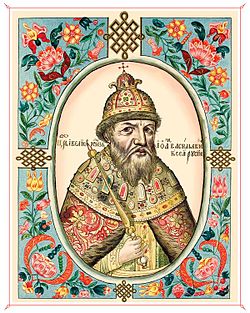
Back Iwan die Verskriklike Afrikaans Ivan IV de Rusia AN Iohannes se Egesiga ANG إيفان الرهيب Arabic ايفان الرهيب ARZ Iván IV de Rusia AST IV İvan Qroznı Azerbaijani دؤردونجو ایوان AZB Иван Грозный Bashkir Іван IV Грозны Byelorussian
| Ivan the Terrible Иван IV | |||||
|---|---|---|---|---|---|
 Portrait of Ivan IV in the Tsarsky titulyarnik, 1672 | |||||
| Tsar of all Russia | |||||
| Reign | 26 January 1547 – 28 March 1584[a] | ||||
| Coronation | 26 January [O.S. 16 January] 1547 | ||||
| Predecessor | Himself as Grand Prince of all Russia | ||||
| Successor | Feodor I | ||||
| Grand Prince of Moscow and all Russia | |||||
| Reign | 13 December 1533 – 26 January 1547[b] | ||||
| Predecessor | Vasili III | ||||
| Successor | Himself as Tsar of all Russia | ||||
| Regent | Elena Glinskaya (1533–1538) | ||||
| Born | 25 August [O.S. 15 August] 1530 Kolomenskoye, Grand Duchy of Moscow | ||||
| Died | 28 March [O.S. 18 March] 1584 (aged 53) Moscow, Tsardom of Russia | ||||
| Burial | Cathedral of the Archangel, Moscow | ||||
| Spouses | |||||
| Issue Detail | |||||
| |||||
| Dynasty | Rurik | ||||
| Father | Vasili III of Russia | ||||
| Mother | Elena Glinskaya | ||||
| Religion | Russian Orthodox | ||||
Ivan IV Vasilyevich (Russian: Иван IV Васильевич;[c] 25 August 1530 – 28 March [O.S. 18 March] 1584), commonly known as Ivan the Terrible,[d] was Grand Prince of Moscow and all Russia from 1533 to 1547, and the first Tsar and Grand Prince of all Russia from 1547 until his death in 1584.[3] Ivan's reign was characterised by Russia's transformation from a medieval state to a fledgling empire, but at an immense cost to its people and long-term economy.
Ivan IV was the eldest son of Vasili III by his second wife Elena Glinskaya, and a grandson of Ivan III. He succeeded his father after his death, when he was three years old. A group of reformers united around the young Ivan, crowning him as tsar in 1547 at the age of 16. In the early years of his reign, Ivan ruled with the group of reformers known as the Chosen Council and established the Zemsky Sobor, a new assembly convened by the tsar. He also revised the legal code and introduced reforms, including elements of local self-government, as well as establishing the first Russian standing army, the streltsy. Ivan conquered the khanates of Kazan and Astrakhan, and significantly expanded the territory of Russia.
After he had consolidated his power, Ivan rid himself of the advisers from the Chosen Council and triggered the Livonian War of 1558 to 1583, which ravaged Russia and resulted in failure to take control over Livonia and the loss of Ingria, but allowed him to establish greater autocratic control over the Russian nobility, which he violently purged using Russia's first political police, the oprichniki. The later years of Ivan's reign were marked by the massacre of Novgorod by the oprichniki and the burning of Moscow by the Tatars. Ivan also pursued cultural improvements, such as importing the first printing press to Russia, and began several processes that would continue for centuries, including deepening connections with other European states, particularly England, fighting wars against the Ottoman Empire, and the conquest of Siberia.
Contemporary sources present disparate accounts of Ivan's complex personality. He was described as intelligent and devout, but also prone to paranoia, rage, and episodic outbreaks of mental instability that worsened with age.[4][5][6] Historians generally believe that in a fit of anger, he murdered his eldest son and heir, Ivan Ivanovich;[7] he might also have caused the miscarriage of the latter's unborn child. This left his younger son, the politically ineffectual Feodor Ivanovich, to inherit the throne, a man whose rule and subsequent childless death led to the end of the Rurik dynasty and the beginning of the Time of Troubles.[8]
Cite error: There are <ref group=lower-alpha> tags or {{efn}} templates on this page, but the references will not show without a {{reflist|group=lower-alpha}} template or {{notelist}} template (see the help page).
- ^ "Иван Васильевич Грозный". www.hrono.ru. Retrieved 20 August 2021.
- ^ ""Иван Грозный — первый русский модернист"". Год Литературы (in Russian). Retrieved 20 August 2021.
- ^ a b Halperin, Charles J. (13 January 2014). "Ivan IV the Terrible, Tsar of Russia". Renaissance and Reformation. doi:10.1093/OBO/9780195399301-0099. ISBN 978-0-19-539930-1.
- ^ Shvidkovskiĭ, Dmitriĭ Olegovich (2007) Russian Architecture and the West. Yale University Press. p. 147. ISBN 0300109121.
- ^ Yanov, p. 208
- ^ Del Testa, David W. (2001) Government Leaders, Military Rulers and Political Activists. Greenwood Publishing Group. p. 91. ISBN 1573561533
- ^ Perrie & Pavlov 2014, p. 192.
- ^ Moss, Walter G. (July 2003). A History of Russia: Volume I: to 1917. Anthem Press. ISBN 978-0-85728-752-6.